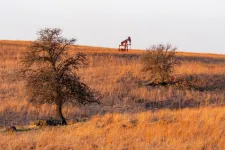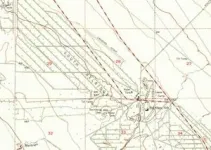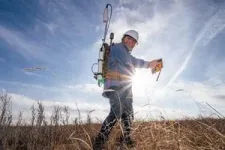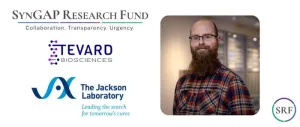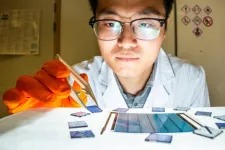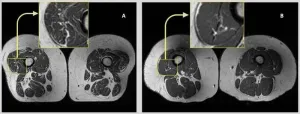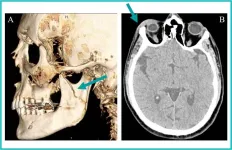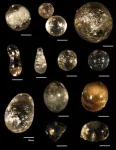If the wells weren’t properly plugged, they can potentially leak oil and chemicals into nearby water sources or send toxic substances like benzene and hydrogen sulfide into the air. They can also contribute to climate change by emitting the greenhouse gas methane, which is about 28 times as potent as carbon dioxide at trapping heat in our atmosphere on a hundred-year timescale (with even higher global warming potential over shorter periods).
To find UOWs and measure methane emissions in the field, researchers are using modern tools, including drones, laser imaging, and suites of sensors. But the contiguous United States covers more than 3 million square miles. To better predict where the undocumented wells might be, researchers first pair the new with the old: modern artificial intelligence (AI) and historical topographic maps.
“While AI is a contemporary and rapidly evolving technology, it should not be exclusively associated with modern data sources,” said Fabio Ciulla, a postdoctoral fellow at the Department of Energy’s Lawrence Berkeley National Laboratory (Berkeley Lab) and lead author of a case study on using artificial intelligence to find UOWs published today in the journal Environmental Science & Technology. “AI can enhance our understanding of the past by extracting information from historical data on a scale that was unattainable just a few years ago. The more we go into the future, the more you can also use the past.”
Since 2011, the United States Geological Survey has uploaded 190,000 scans of historical USGS topographic maps made between 1884 and 2006. Crucially, the maps are geotagged, meaning each pixel corresponds to coordinates that can be easily referenced.
Ciulla pulled together quadrangle maps, rectangular maps that cover a set amount of latitude and longitude and were mapped at a scale where one inch represents 2000 feet. Between 1947 and 1992, these maps also used consistent symbols for oil and gas wells: a hollow black circle.
“For a human being, looking at this circle and recognizing it is extremely easy,” Ciulla said. “Until recently, this was the only available method to extract information from these maps – but that strategy does not scale well if we want to apply it to thousands of maps. This is where artificial intelligence comes into play.”
For this approach to work, the Berkeley Lab research team needed to teach the AI how to identify the correct symbols amidst all the other visual information. It also needed to work on maps with different terrain and colors, as well as maps in different conditions (old, new, stained, pristine).
“This problem is equivalent to finding a needle in a haystack, since we are trying to find a few unknown wells that are scattered in the midst of many more documented wells,” said Charuleka Varadharajan, a scientist at Berkeley Lab and senior author of the study.
Researchers used a digital tool to manually mark oil wells on nearly 100 maps from California and create a training set for the AI. Once taught to find the hollow circles and to ignore false positives (such as cul-de-sacs or symbols with circular patterns, like the number 9 or letter “o”), the algorithm could be applied to any of the USGS maps with the same symbols. And because the maps were georeferenced, the algorithm could take the coordinates for the oil wells marked on the map and compare them with coordinates for documented wells.
To detect a potential undocumented orphaned well, the team selected well symbols that were more than 100 meters from a known well to account for potential errors in well coordinates. They also built a novel tool that lets a human quickly vet what the algorithm finds, double checking that the AI is correctly interpreting the symbols on the map.
Researchers used the AI algorithm to scour four counties of interest that had substantial early oil production – Los Angeles and Kern counties in California, and Osage and Oklahoma counties in Oklahoma – and found 1,301 potential undocumented orphaned wells. So far, researchers have verified 29 of the UOWs using satellite images and another 15 from surveys in the field; additional investigation on the ground will be needed to confirm other potential wells.
“With our method, we were conservative about what would be considered as a potential undocumented orphaned well,” Varadharajan said. “We intentionally chose to have more false negatives than false positives, since we wanted to be careful about the individual well locations identified through our approach. We think that the number of potential wells we’ve found is an underestimate, and we might find more wells with more refinement of our methods.”
From the map to the field
The first pass at verifying an undocumented well happens remotely. Researchers consult satellite images and historical aerial photos, looking for features like oil derricks and pump jacks (or their shadows), lifting equipment, oil pads, storage tanks, or disturbed ground.
In many cases, wells were capped at or below the surface level, leaving no obvious sign in reference images. Instead, researchers need to head into the field with equipment to confirm whether a well exists.
At a predicted well location, researchers look for any surface well structures. If there aren’t any, they walk in a grid or spiral pattern carrying a magnetometer, which measures magnetic fields. Buried metal well casings disturb the magnetic field, allowing researchers to home in on the well. Once they finish surveying the area, researchers save the magnetometer file, record whether or not a well was found, and – if so – take a picture of the site, record GPS coordinates, and check for methane leaks.
For the wells they could verify, the Berkeley Lab team found the UOWs were located an average of 10 meters from where the algorithm and map predicted. They believe the AI approach is the first that can identify the precise locations for potential UOWs at county scales. And with the bounty of maps covering the United States, the technique can be scaled up and translated to other regions of interest.
The AI mapping and verification effort is part of a much larger project to address UOWs: the Consortium Advancing Technology for Assessment of Lost Oil & Gas Wells (CATALOG). The program is led by Los Alamos National Laboratory and includes research teams from Berkeley Lab, Lawrence Livermore National Laboratory, the National Energy Technology Laboratory, and Sandia National Laboratories.
It’s a big collaboration to address an equally sprawling problem: The Interstate Oil and Gas Compact Commission estimated in 2021 that there are somewhere between 310,000 and 800,000 undocumented orphaned wells across the United States.
Regulations for drilling and plugging emerged at different times in different states, long after the first wells were drilled. In early years of drilling, many wells were left open or filled with questionable plugs, making it possible for oil, gas, brine, or chemicals to later escape. Once identified, wells can be properly “plugged and abandoned” by filling the borehole with cement, keeping oil out of water and methane out of the atmosphere.
CATALOG aims to improve ways to find wells, detect and measure methane, rapidly screen wells for their condition, unite information from different sources, and prioritize wells for plugging. The goal is to create tools (like AI well prediction) that can be used anywhere in the United States and are inexpensive enough to be adopted.
At nearly 1.5 million acres, the Osage Nation acts as one proving ground for CATALOG’s technology and techniques. Partners from the Osage Nation provide essential feedback, evaluating the pros and cons of the equipment used in the field and the accuracy of the information generated.
“The collaboration between the Osage Nation and CATALOG has been mutually beneficial and productive,” said Craig Walker, director of Osage Nation Natural Resources. “Utilizing AI and state-of-the-art detection equipment has filled data gaps in records and led to the discovery of some undocumented wells in the area, and has streamlined various processes within the Osage Nation Orphan Well Program.”
Berkeley Lab scientist Sebastien Biraud, who leads the CATALOG project at Berkeley Lab, heads the effort to assess sensors and new methods to detect and quantify methane emissions. Groups investigating orphaned wells need to quickly assess how much methane is leaking, but high-tech methane sensors are expensive.
Biraud’s team is working on how lower-cost, off-the-shelf sensors can be combined as an alternative. The setup includes an anemometer to measure wind speed, a fan (for quick flow rate), a gas analyzer, GPS, and the crucial calculations that let a user factor in the distance to the well to determine roughly how much methane coming out.
“We don’t need to know if it’s leaking exactly 2.3 grams per hour,” Biraud said. “We need to know if it’s not leaking, if it’s leaking between 10 and 100 grams per hour, or if it’s leaking kilograms per hour. And we need to be able to do it in five minutes.”
A quick way to measure methane leaks is essential for triaging newly discovered UOWs, and also for efforts to plug known wells.
“There’s a requirement now to quantify emissions before and after plugging an oil and gas well,” Biraud said. “Both because you want to make sure the plugging is done right, and you also want to quantify the impact of the program itself on our climate mitigation strategies – particularly for methane emissions, which can cause global warming impacts more quickly than carbon dioxide.”
From the field to the sky
Researchers in CATALOG are also investigating ways to scale up undocumented well detection and verification using drones equipped with different sensors. Preprogrammed with set fly routes, the drones can semi-autonomously survey a larger area than researchers could easily access on the ground.
Groups are pursuing several different kinds of sensors, each with their own challenges and benefits. To use a magnetometer from a drone, researchers have to suspend the sensor from a 9-foot cable. If it’s placed closer to the drone, the electronics will interfere with capturing the magnetic signature from a well.
A separate drone carries a methane sensor that sips air as it flies, and can factor in methane concentration, wind speed, and wind direction to pinpoint a well location. Yet another technique is flying hyperspectral cameras that look for wavelengths (not visible to human eyes) associated with plumes of methane. And Berkeley Lab researchers are developing a drone-mounted technology that can pick up hard-to-find oil wells, such as those built with wood casings or wells where the metal was stripped for other uses.
There are still other ways to pick up clues for lost wells. Planes with laser systems known as LIDAR can image the ground. Thermal cameras can point toward hidden leaks. CATALOG members are even developing an app that uses a smartphone’s magnetometer to search for wells.
“The right way to attack this problem is a multi-layer approach,” said Ciulla. “We can layer the information from all these different sources almost as if it were a cake. I can give my contribution with historical maps, someone else can do computations for historical oil production, others bring images or satellites or sensor data. It’s a beautiful mix of the old and the new, and I’m fascinated that maps, something that seems so old-fashioned and static, can give us so much useful information if correctly used with the help of current technology.”
CATALOG’s work to build up tools to curb methane emissions and hazards from undocumented orphaned wells is ongoing.
“We, as a society, really like energy,” Biraud said. “But we need to find solutions that limit our emissions. And working with local stakeholders like Native American tribes, the U.S. Forest Service, and the U.S. National Parks Service, we’re seeing that this is one way we can have an impact.”
The mapping AI tool used resources provided by the Department of Energy’s National Energy Research Scientific Computing Center (NERSC), a DOE Office of Science user facility.
This work was supported as part of the Consortium Advancing Technology for Assessment of Lost Oil & Gas, funded by the U.S. Department of Energy, Office of Fossil Energy and Carbon Management, Office of Resource Sustainability, Methane Mitigation Technologies Division’s Undocumented Orphan Wells Program.
###
Lawrence Berkeley National Laboratory (Berkeley Lab) is committed to delivering solutions for humankind through research in clean energy, a healthy planet, and discovery science. Founded in 1931 on the belief that the biggest problems are best addressed by teams, Berkeley Lab and its scientists have been recognized with 16 Nobel Prizes. Researchers from around the world rely on the lab’s world-class scientific facilities for their own pioneering research. Berkeley Lab is a multiprogram national laboratory managed by the University of California for the U.S. Department of Energy’s Office of Science.
DOE’s Office of Science is the single largest supporter of basic research in the physical sciences in the United States, and is working to address some of the most pressing challenges of our time. For more information, please visit energy.gov/science.
END
